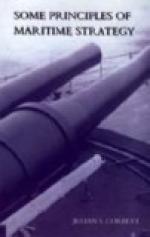As regards the ratio between cruiser and convoy speeds, on which evasion so much depends, it is the same. In frigate days the ratio appears to have been not more than seven to five. Now in the case at any rate of large convoys it would be nearly double.
Of the destructive power of the flotilla, growing as it does from year to year, enough has been said already. With the advent of the torpedo and submarine it has probably increased tenfold. In a lesser degree the same is true of cruisers. In former days the physical power of a cruiser to injure a dispersing convoy was comparatively low, owing to her relatively low excess of speed and the restricted range and destructive power of her guns. With higher speed and higher energy and range in gun power the ability of cruisers to cut up a convoy renders its practical annihilation almost certain if once it be caught, and consequently affords a moral deterrent against trusting to evasion beyond anything that was known before.
The increased ratio of battle-fleet speed to that of large convoys is equally indisputable and no less important, for the facility of finding interior positions which it implies goes to the root of the old system. So long as our battle-fleet is in a position whence it can cover our flotilla blockade or strike the enemy’s convoy in transit, it forces his battle-fleet in the last resort to close up on the convoy, and that, as Kempenfelt pointed out, is practically fatal to the success of invasion.
From whatever point of view, then, we regard the future chances of successful invasion over an uncommanded sea, it would seem that not only does the old system hold good, but that all modern developments which touch the question bid fair to intensify the results which our sea service at least used so confidently to expect, and which it never failed to secure.
II. ATTACK AND DEFENCE OF TRADE
The base idea of the attack and defence of trade may be summed up in the old adage, “Where the carcase is, there will the eagles be gathered together.” The most fertile areas always attracted the strongest attack, and therefore required the strongest defence; and between the fertile and the infertile areas it was possible to draw a line which for strategical purposes was definite and constant. The fertile areas were the terminals of departure and destination where trade tends to be crowded, and in a secondary degree the focal points where, owing to the conformation of the land, trade tends to converge. The infertile areas were the great routes which passed through the focal points and connected the terminal areas. Consequently attack on commerce tends to take one of two forms. It may be terminal or it may be pelagic, terminal attack being the more profitable, but demanding the greater force and risk, and pelagic attack being the more uncertain, but involving less force and risk.




